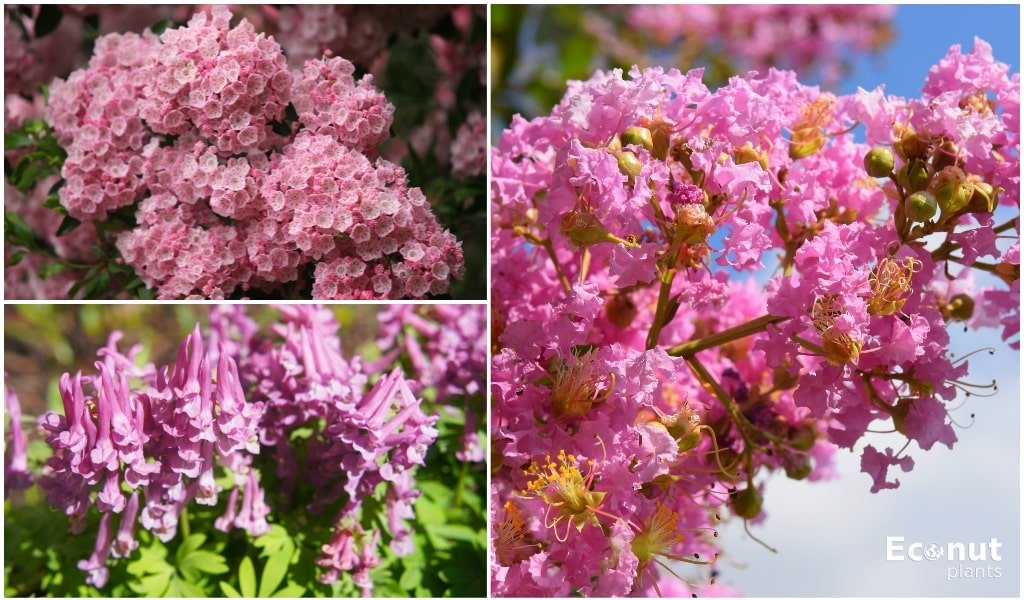Are you considering adding some pink-flowering shrubs to your garden area, but you’re not exactly sure what to search for?
Have a look at the following collection of 35 pink-flowering shrubs that you should add to your garden wish list for this year. Most of them are easy to grow and will thrive in a variety of conditions.
Pink flowers elegantly represent abundance, love, and pleasure. The greatest Pink Flowering Bushes to grow if you want to bring these good characteristics into your garden!
The greatest pink-flowering shrubs for your garden landscape can be chosen with the help of this article. You may choose the ideal bushy plants for your front or garden by looking at names and images of shrubs in different shades of pink.
1. Western Spirea

Scientific Name: Spiraea douglasii
Plant Type: Deciduous shrubs
Plant Size: 4-6 feet tall
Sun Exposure: Full sun to partial shade
Rose-pink blooms from Western Spirea appear in wacky bunches at the top of towering spires. This plant is a favourite for forest or cottage-style gardens because of its charming and romantic pink flowers, which are surrounded by light green foliage.
This shrub grows naturally in bogs and marshes, where it likes damp soil. Even though it loves full light, don’t put it in dry or too-hot soil. This magnificent flowering shrub works well in almost any garden because of its many variants.
2. Bird-In-A-Bush ‘George Barker’
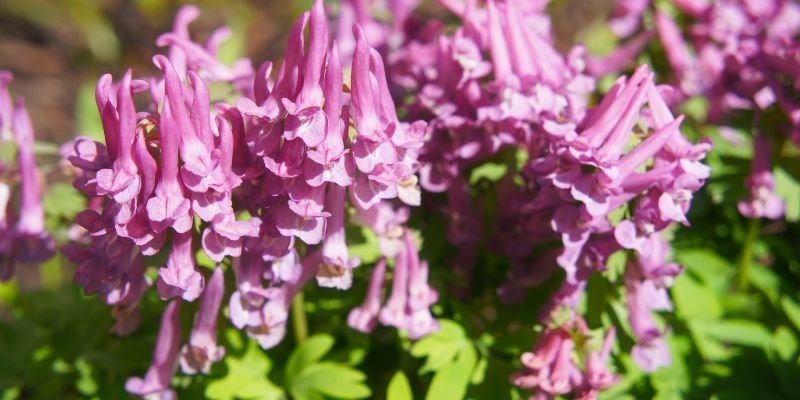
Scientific Name: Corydalis solida
Plant Type: Herbaceous perennial
Plant Size: 10 inches tall with 10-inch spread
Sun Exposure: Full sun to partial shade
Bird-in-a- Bush, often called fumewort, is a technically herbaceous perennial that forms a shrub when pruned. But in the spring, when its leaves are dense, it covers borders or beds in a manner similar to that of a conventional shrub.
The foliage will wither away in the summer heat and be replaced only by the stalks of tuberous roots until the following blooming season.
This floral plant is stunning and fascinating when it blooms. Its tubular flowers dangle from towering spikes, as do its delicate green fern-like leaves. The combo reminds me of woodlands from fairy tales.
Bird-in-a- Bush is typically found in mauve or white variants; however, the ‘George Barker’ variety has vivid pink, almost red, flowers instead. It would look great in a meadow-inspired plot or forest garden.
3. Rose of Sharon
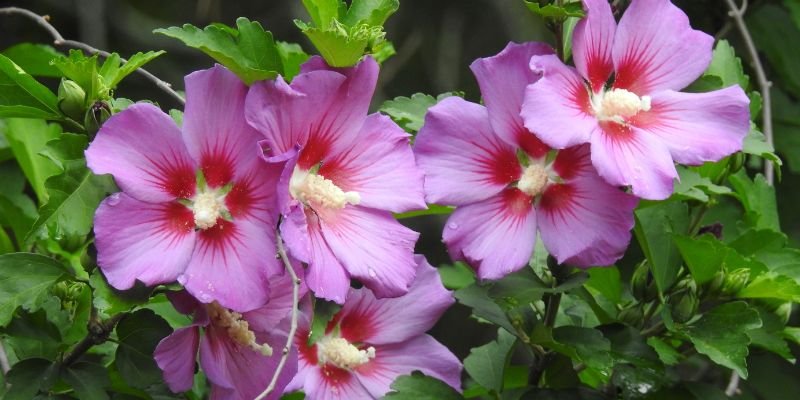
Scientific Name: Hibiscus syriacus
Plant Type: Hardy deciduous shrub
Plant Size: 8 to 12 feet tall and 6 to 10 feet wide
Sun Exposure: Prefers Full Sun
Like hydrangea, gardeners who observe the bloom sequence of Hibiscus syriacus will find that this shrub makes a terrific friend. This is because, throughout the late summer, when few other shrubs will provide colour to your landscape, the rose of Sharon will.
‘Sugar Tip’ is one cultivar that has pink blooms and two-toned foliage. It grows to a height of 8 to 12 feet and a width of 4 to 6 feet (zones 5 to 9).
‘Woodbridge’ is another that grows in zones 5 to 9 and has pink flowers. Woodbridge grows to a height of 8 to 10 feet and a width of 5 to 6 feet. Find it in direct sunlight.
4. Pink Shrub Roses
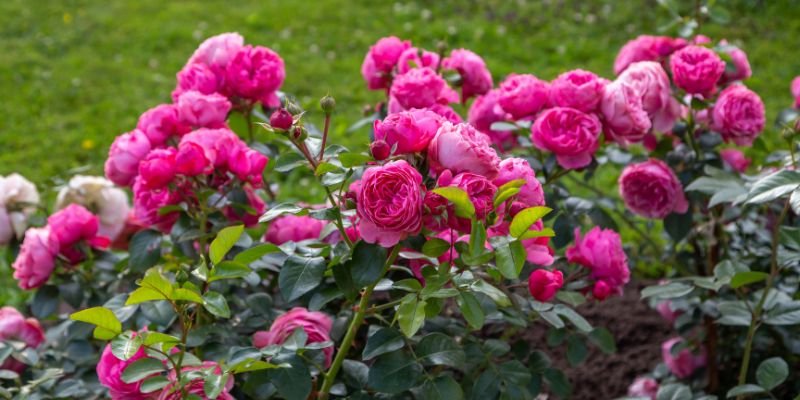
Scientific Name: Rosa meldomonac
Plant Type: Perennial Shrubs
Plant Size: 3-4 feet
Sun Exposure: Full sun or partial sun
Gorgeous, compact, sun-loving bushes, pink shrub roses produce clusters of double, vividly pink flowers. The gorgeous blossoms that adorn the shrubs throughout the season and their pinnate leaves, which have tiny oval leaflets, are characteristics that set them apart. There are shrub rose variants that are thornless.
Shrub roses with pink flowers can grow up to 3″ (7.5 cm) in diameter and are hardy perennials. From late spring to early October, there is a continual display of flowers, which thrive in full sun. Pink shrub roses can provide a gorgeous focal point in the yard with their typical growth of up to 5 feet (1.5 meters) in height and width.
The pink-flowering, bushy shrub rose is a versatile plant for sunny settings because it requires minimal maintenance, is easy to grow, and is resistant to drought.
5. Butterfly Bush

Scientific Name: Buddleja davidii
Plant Type: deciduous shrub
Plant Size: 6-12 feet tall
Sun Exposure: Full sun
There are several varieties of butterfly bushes that you can cultivate, just like there are for many other plants on our list. While some of these also have a hint of lavender mixed in, most of them are pink.
All grow best in full light; zones 5 to 9 are optimal. When choosing a cultivar with blush blossoms, “Pink Micro Chip,” “In Spired Pink,” and “Pink Delight” are some of the best options.
Also Read: Red Flowers
6. Chinese Hibiscus
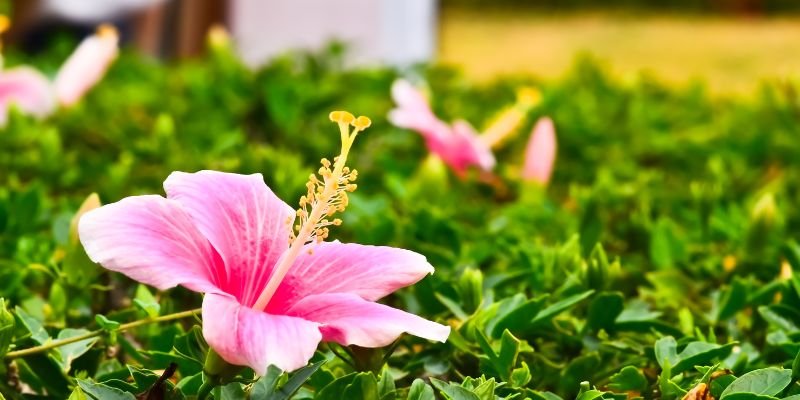
Scientific Name: Hibiscus rosa-sinensis
Plant Type: Evergreen shrub
Plant Size: 4-10 feet tall, 3-6 feet wide
Sun Exposure: Full sun
The national flower of Malaysia is the Chinese hibiscus, which is used there to adorn everything from thrones to regal attire. In the past, people utilized the vivid and eye-catching bloom as an antidote to poison and many illnesses, leading to the belief that it had therapeutic properties.
Of course, Chinese hibiscus is more for show than purpose in a contemporary garden, but show it does! This shrub has up to 10-inch-diameter blooms that have a variety of hues, including pink. The blossoms are gorgeous against the glossy, dark green leaves.
Provide full sun for your Chinese Hibiscus plant to get the most blooms possible. There won’t be as many blossoms, but this plant can take mild shade.
7. Rose
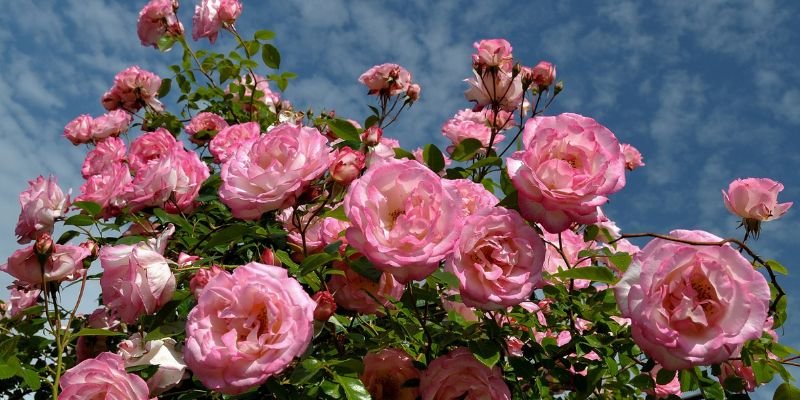
Scientific Name: Rosa
Plant Type: Perennial flowering
Plant Size: 8 inches to over 50 feet tall
Sun Exposure: Full sun
One of the most popular flowers in the world is the rose. A robust rose bush is frequently considered a valuable asset to a gardener’s collection, as it brings elegance and beauty to any landscape.
This flower also comes in a variety of sizes and forms. In addition to “roses with exceptional fragrance,” climbing roses, rambler roses, ground-cover roses, and, most interestingly, shrub roses are also available.
We can’t go into detail on each species of rose here, but they all have a fascinating history. We can remark that there are several proudly pink shrub rose selections available, such as “Apothecary’s Rose,” “Gertrude Jekyll,” “Princess Alexandra of Kent,” “Frantasia,” and more.
8. Pink Azalea

Scientific Name: Rhododendron
Plant Type: Flowering shrub
Plant Size: 3–5 feet
Sun Exposure: Full Sun/Partial Shade
One of my favourite flowering plants to grow in a garden is the pink azalea. The various pink hues of azaleas represent femininity. These flowers, which resemble shrubs when they develop, are frequently utilized in gardens as privacy curtains.
Azalea blooms are available all spring and summer. Its vivid pink blossoms never fail to draw attention, and I’ve discovered a few tips to maintain their health.
Pick a location for your pink azalea planting that receives full sun to partial shade and well-draining soil. This aids in preserving the ideal ratio of light to moisture. Watering on a regular basis is essential, but to prevent root rot, don’t overdo it.
I advise pruning the shrub to keep it in shape and promote new growth once it has flowered. Mulch around the base helps retain soil moisture and inhibits the growth of weeds. You will always have a magnificent pink azalea display if you follow these care instructions.
9. Carnation
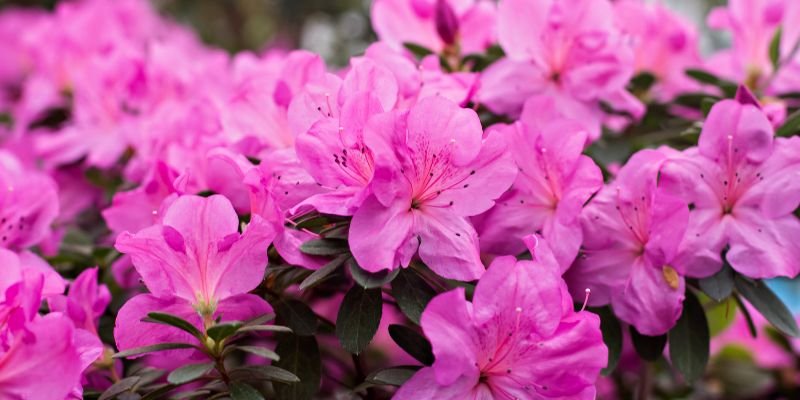
Scientific Name: Dianthus caryophyllus
Plant Type: herbaceous plant
Plant Size: 30 to 75 cm (1 to 2.5 feet)
Sun Exposure: Partial Sun
The pinnacle of classic smell and beauty are carnations. I’ve cultivated a good many of these pink flowers as an experienced gardener, and they never cease to amaze.
Carnations are naturally pink or pinkish, but they can also be purple, orange, white, green, red, or blue through selective breeding and genetic engineering. Since they are edible, carnations are frequently used as garnishes.
I advise growing carnations in well-draining soil that receives full sun to partial shade exposure in order to ensure their success. It’s imperative to water frequently, letting the soil dry out a little in between applications.
A balanced floral fertilizer used every two to three weeks promotes robust growth and the profusion of blooms. In addition to keeping the plant neat, deadheading spent flowers promotes continued blossoming. I shelter my carnations from wind and rain to maintain the delicate blossoms.
Your carnations will bring a wonderful pop of pink and an air of elegance and fragrance to your landscape with the right care and attention.
10. Quince
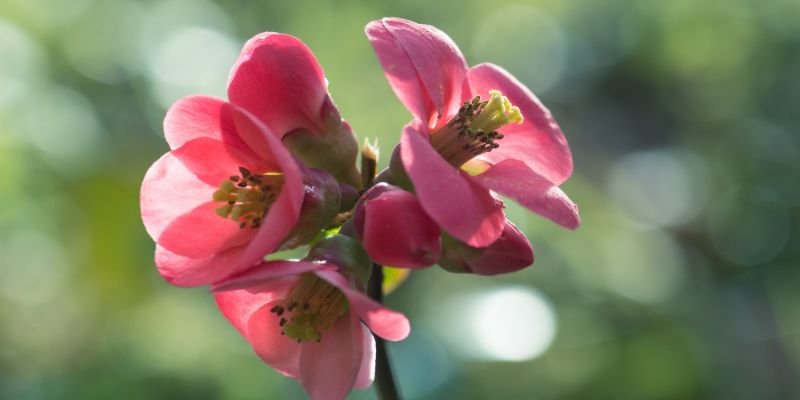
Scientific Name: Cydonia oblonga
Plant Type: deciduous shrub
Plant Size: 3-10 ft. tall, 3-10 ft. wide
Sun Exposure: full sun or partial shade
Quince is a low-maintenance shrub that offers brilliant tones of pink and other hues of early spring beauty. Choose a spot with lots of afternoon shade if you intend to plant this shrub in a warmer climate; this will prolong the blooms. Consider the cultivar “Double Take Pink Storm” for the most vibrant pink hues.
Also Read: Vines with Purple Flowers
11. Hydrangea
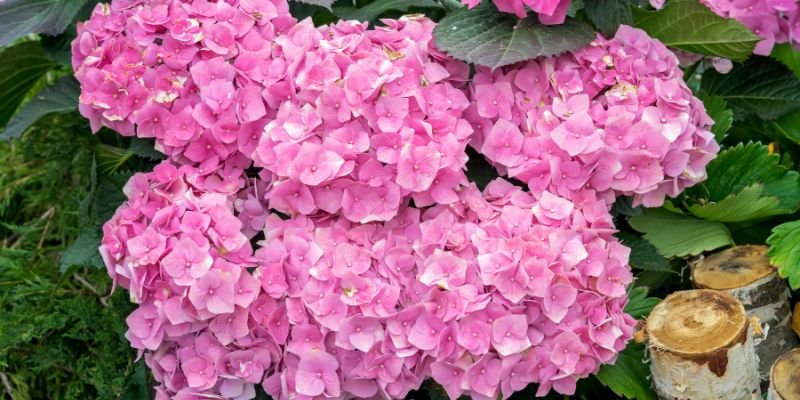
Scientific Name: Hydrangea
Plant Type: deciduous shrub
Plant Size: 1 to 3 feet, Width 2 to 12 feet
Sun Exposure: partial sun
You can cultivate a wide variety of hydrangeas, all of which are valued for the beauty and visual appeal they offer over the majority of the summer. Although pink-flowering varieties are the most common, you can also find white, blue, and even purple hydrangeas. The cultivars “Invincibelle Spirit” and “Pink Elf” are two to take into consideration for their unending pink blossoms.
12. Mountain Laurel
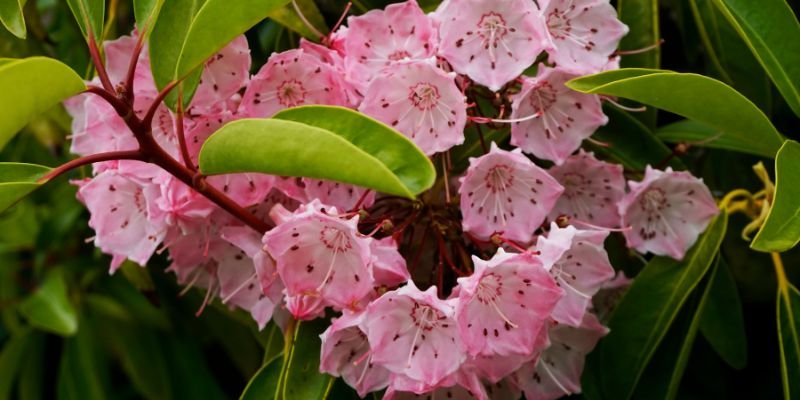
Scientific Name: Kalmia latifolia
Plant Type: evergreen shrub
Plant Size: 5 to 15 ft. (1.5 – 4.5 m)
Sun Exposure: partial shade
The gorgeous clusters of pink spring blooms that the mountain laurel, an evergreen shrub with pink flowers, is noted for.
The deep rose markings and dark pink stamens accentuate the bell-shaped pink blossoms. The rich green, glossy leaves of the mountain laurel add to the plant’s overall appeal.
The pink blooms of this shade-loving shrub give a garden setting a striking pop of colour. Large shrubs like this one thrive well in naturalized regions, cottage gardens, and shrub borders. One of the most exquisite shrubs for gardens in North America is this native plant with pink flowers.
13. Smoke Bush
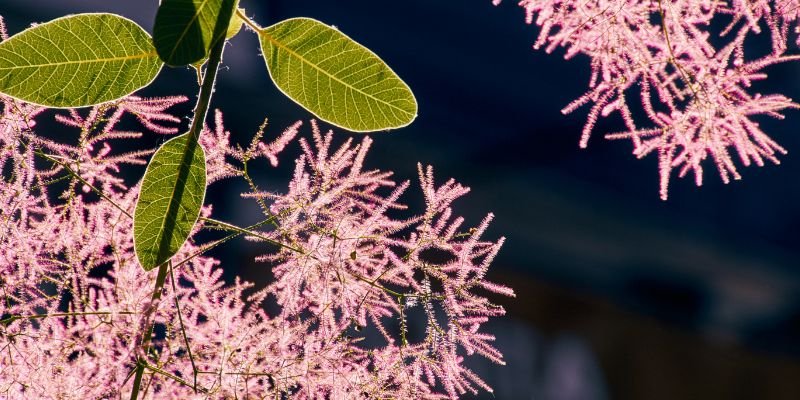
Scientific Name: Cotinus coggygria
Plant Type: deciduous shrub
Plant Size: 10-15 ft. tall and wide
Sun Exposure: Full sun
The smoke bush, also known as Cinnamon coggygria, is a tiny tree or deciduous shrub that blooms from late spring to July. During this time, the flowers of the plant change colour from a smokey pink to a purplish pink.
Drought-tolerant and useful as a specimen plant or focal point, smoke bush has distinctive billowy-haired flowers, multi-stemmed leaves that change colour in the fall (depending on the cultivar), and waxy green or purple foliage.
14. Sonic Bloom Pink Weigela
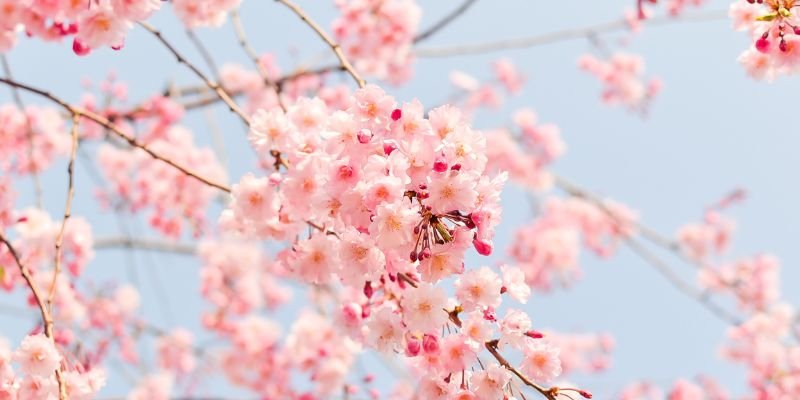
Scientific Name: Weigela florida ‘Bokrasopin
Plant Type: deciduous shrub
Plant Size: 4-5 ft
Sun Exposure: Full sun
The weigela plant is typically thought of as a thick shrub that blooms pink in the spring. Summertime may see the blossoms return. There are new varieties that offer more summer and fall flowers in a wider variety of hues.
The red, pink, and white Sonic Bloom series features repeating flowers from spring to fall. It grows to be 4 to 5 feet tall and wide when planted in full light.
15. Zinnia
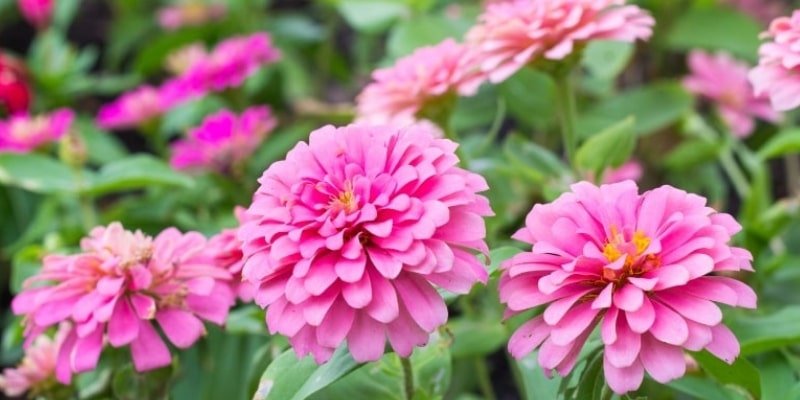
Scientific Name: Zinnia elegans
Plant Type: Annuals, shrubs, or sub-shrubs
Plant Size: 6 inches to 4 feet tall, 1 to 2 feet wide
Sun Exposure: Full sun
Zinnias, one of the most colourful and adaptable flowers to grow, can have solitary, semi-double, or voluminous double blooms. Because of their robust branches and ability to withstand heat and drought, these sun-lovers are perfect for bouquets with cut flowers. Find out more about cultivating flowers from zinnias.
16. Darley Dale Winter Heath
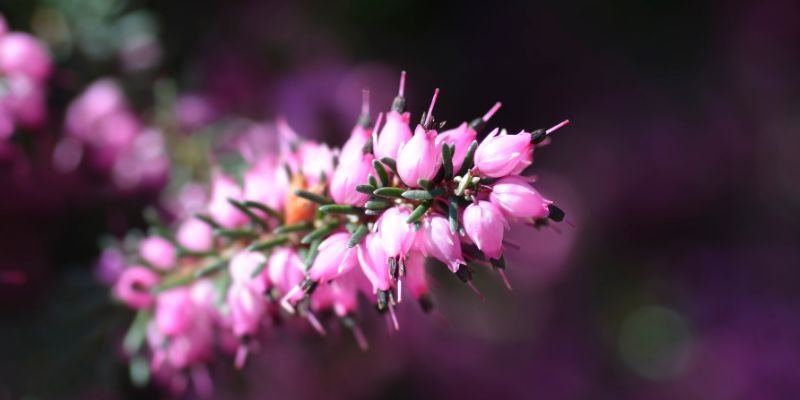
Scientific Name: Erica x darleyensis
Plant Type: perennial
Plant Size: 18 inches tall, 3-foot spread
Sun Exposure: Full sun
Short and shrubby, Darley Dale Winter Heath is a perennial hybrid that makes a great ground cover or boundary plant. It is incredibly resilient and simple to grow, able to resist extreme temperatures.
The pink blossoms on this hardy plant age from pale pink to deep pink, with colour changing from fall to mid-spring. In the spring, the green foliage that envelops the blossoms becomes creamy white at the tips, adding a stunning pop of colour to any garden.
Also Read: Houseplants Red Leaves
17. February Daphne
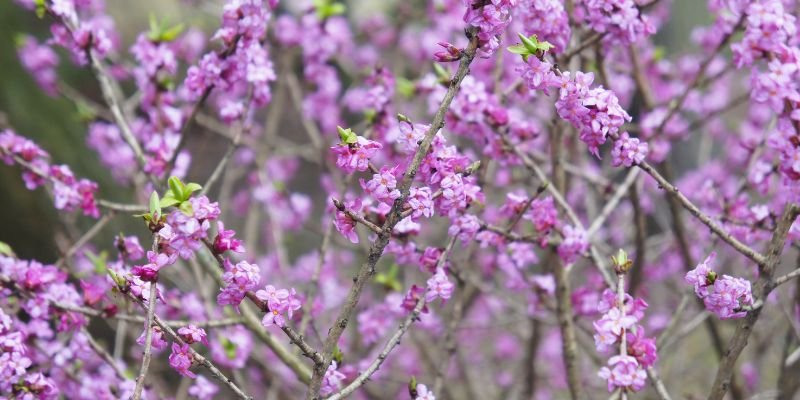
Scientific Name: Daphne mezereon
Plant Type: Deciduous shrub
Plant Size: 3-5 feet tall with 3-5 foot spread
Sun Exposure: Full sun to partial shade
Daphne is found in Europe’s chilly, moist woodlands, where it is native. Daphne was brought by colonial settlers to America and Canada, where it became naturalized.
This pink-blooming shrub has the name of the Greek nymph Daphne. Purplish-pink cluster blooms bloom early and late in winter, giving February Daphne its unique name.
These blossoms are utterly captivating when contrasted with the shrub’s deep green foliage. Sadly, they also contain poison.
18. Petite Salmon
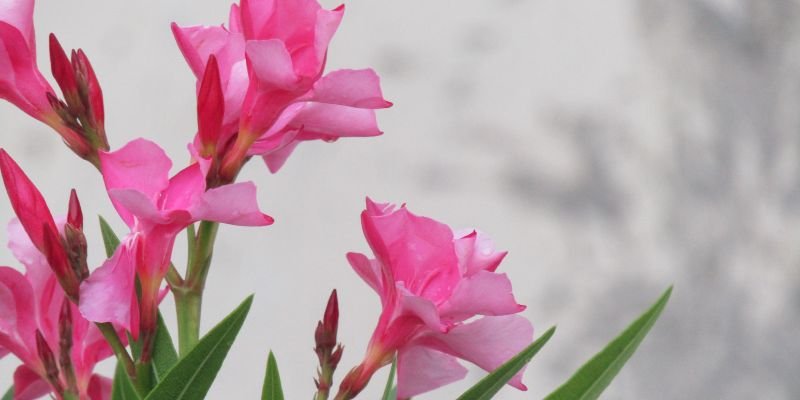
Scientific Name: Nerium oleander
Plant Type: evergreen shrub
Plant Size: 3 to 6 feet
Sun Exposure: Full sun
While there are a few oleander cultivars with pink blossoms, we have selected ‘Petite Salmon’ due to its uncommon, elegant, and refined tint.
The fragrant five-petaled blossoms are plentiful on this evergreen shrub, as is their highly sought-after shade of salmon pink.
Finally, because this is a dwarf variety with its glossy, lance-shaped, light green foliage, you may grow it in containers and protect it from the winter weather if you live in a cold climate.
“Pink Salmon” is a great way to bring back a little bit of the beauty and ambiance of the Mediterranean in tiny urban and suburban gardens, as well as on patios and terraces.
19. Camellia
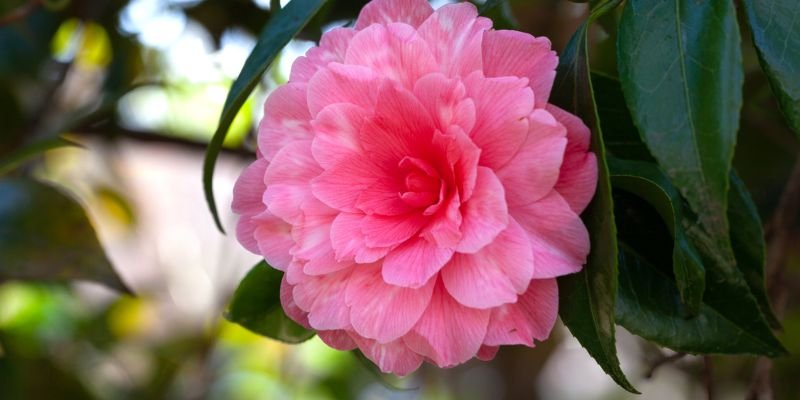
Scientific Name: Camellia japonica
Plant Type: Perennial, tree, shrub
Plant Size: 20 feet tall and 10 feet wide
Sun Exposure: Full shade
These exquisite bushes have glossy leaves and stunning jewel-toned blooms. Usually in early spring or around the holidays, they blossom. Plant them in areas where you can smell them.
20. Bougainvillea
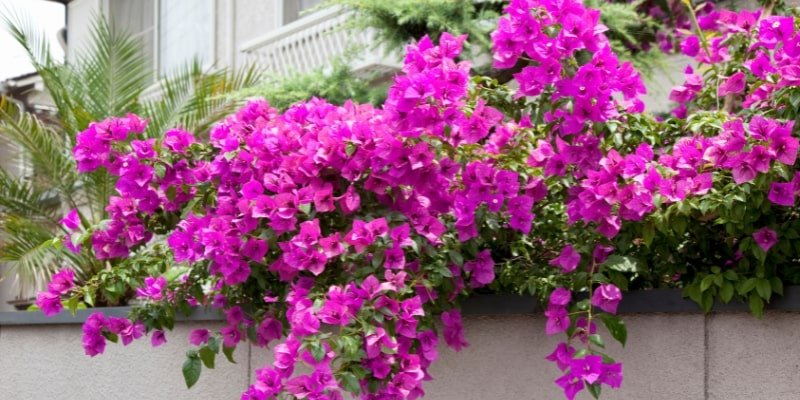
Scientific Name: Bougainvillea
Plant Type: Perennial, tree, shrub
Plant Size: 20 to 30 feet tall and wide
Sun Exposure: Full sun
Bougainvillea is a South American native, but since it arrived in Britain, it has had a significant influence. As they are planted in a room or yard, the clearly summertime blossoms appear to spill out, filling the space with a multitude of pink hues.
Growing to a very respectable size of 4–8 m high by 1–1.5 m broad, this shrub blooms in the summer and autumn. With protection from the summer’s harvest sun, bougainvillea will grow most readily in the sun. Growing it outside in the summer is possible due to its resilience.
It may not be the best choice for inexperienced gardeners, though, as bougainvillea is thought to be a somewhat sensitive plant.
21. Elderberry
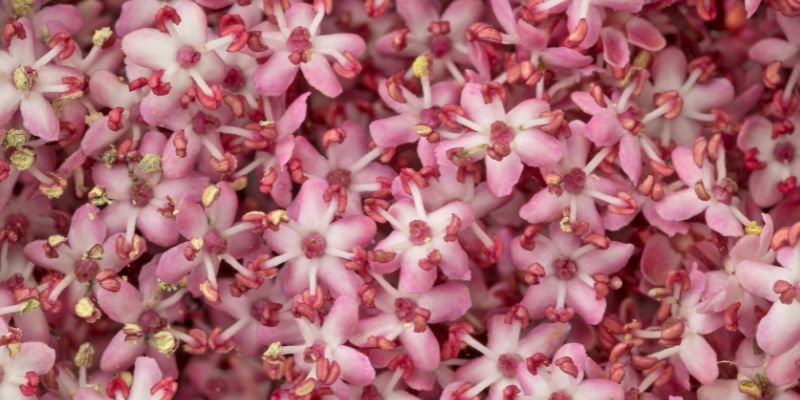
Scientific Name: Sambucus
Plant Type: shrubs
Plant Size: 5–12 feet tall and 6–10 feet wide
Sun Exposure: Full sun
Elderberry varieties that produce beautiful pink blossoms include “Black Lace” and “Black Beauty,” among others. These are a lovely contrast to the dark foliage of the plant, and they can be produced at any time between early spring and midsummer.
It can be cultivated as a smaller perennial or as a shrub. In the fall, it also yields berries that can be picked and used to make jam or wine.
22. Chinese Plum
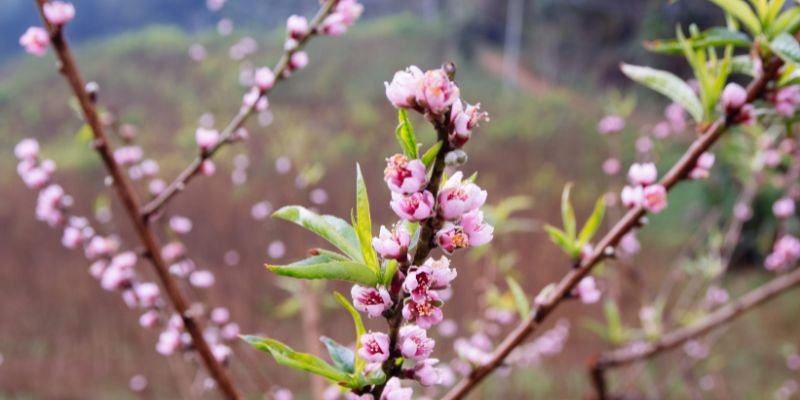
Scientific Name: Prunus salicina
Plant Type: deciduous shrub
Plant Size: 20–33 feet tall
Sun Exposure: full or part sun
Beautiful pink blooms resembling cherries are produced by the deciduous Chinese plum shrub. Early spring brings clusters of pinkish-white blossoms covering the stems.
The shrub features oblong leaves that turn an unattractive yellow in the fall, along with weak stems that give it an uneven shape. After the pink blossoms come round crimson fruits.
This little deciduous shrub, often called the flowering almond, produces a beautiful show of pink blossoms in early spring before the leaves appear, thanks to its cherry-like double flowers.
The dwarf flowering almond tree is most often used as a decorative shrub for front or backyard gardens. As a focal point in any landscape, they enhance its beauty and scent.
23. Summersweet
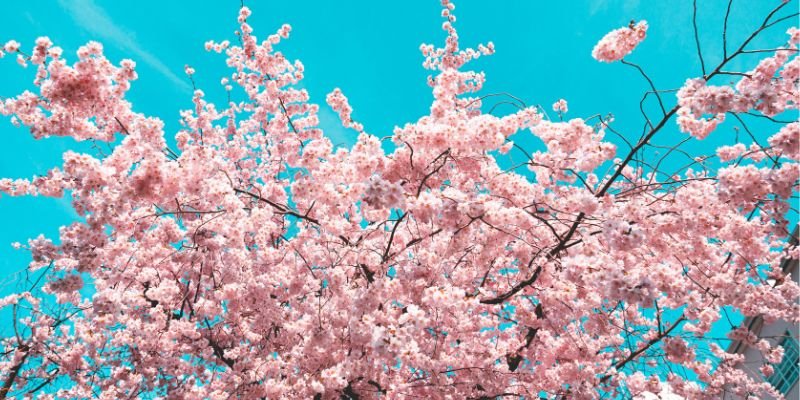
Scientific Name: Clethra alnifolia
Plant Type: Deciduous shrub
Plant Size: 3-8 ft. tall, 4-6 ft. wide
Sun Exposure: Full sun, part shade
One of the greatest pink shrubs to grow if you want pink colour in a shaded garden is summersweet, which blooms best in gloomy locations. There are some varieties with exceptionally lengthy growing seasons, such as “Ruby Spice.” This plant can reach a height of five feet!
24. Summer Wine Ninebark
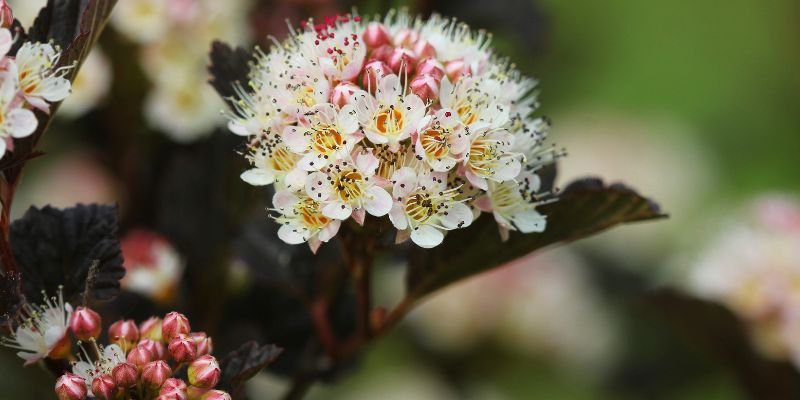
Scientific Name: Physocarpus opulifolius
Plant Type: Deciduous shrub
Plant Size: 5–6 feet tall and wide
Sun Exposure: Full sun
Mature stems of this lovely deciduous shrub peel back to reveal scarlet and light brown inner bark. Summer Wine is a pink-flowering shrub that reaches heights of 5 to 8 feet and widths of up to 8 feet. Its foliage is exceptionally dark purple, almost black. This tolerant plant can grow in most types of soil and thrives in full sun.
25. Chinese Fringe Flower
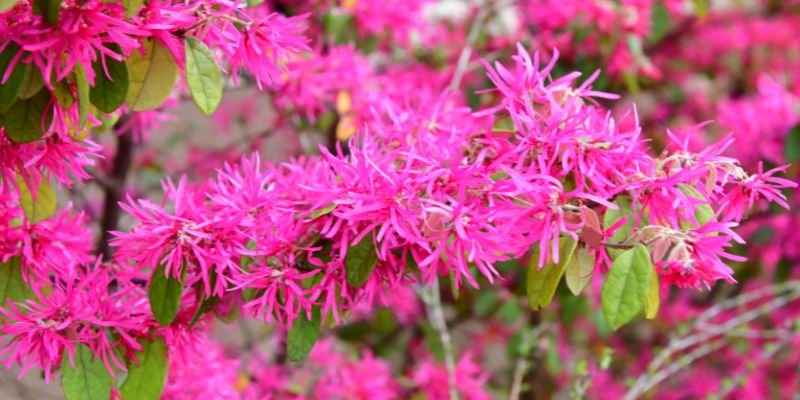
Scientific Name: Loropetalum chinense
Plant Type: Shrub
Plant Size: Height 2 to 10 feet Width 3 to 10 feet
Sun Exposure: Part Sun, Sun
The Chinese fringe-flower shrub (Loropetalum chinense var. rubrum) has pink blooms with unique shapes, similar to the bottlebrush bush. These flowers are made up of several strap-like petals. In zones 7 through 10, the plant can grow up to 12 feet by 12 feet and is a little harder than a bottlebrush bush.
Again, if you live farther north, the equivalent is not very good in terms of blossom shape: witch hazel (Hamamelis x intermedia ‘Arnold Promise’), which has yellow petals instead of pink ones that resemble straps.
The primary characteristic of witch hazel that makes it famous is that it blooms as one of the earliest shrubs (in early spring or late winter).
Also Read: Succulents Types
26. Boomerang Dwarf Pink Lilac
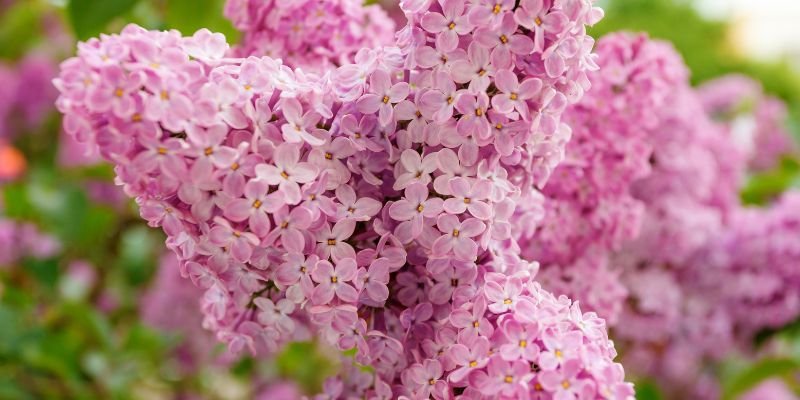
Scientific Name: Syringa
Plant Type: Deciduous shrub
Plant Size: 30-36 in. tall
Sun Exposure: Full sun
Lilacs look great in any garden as a hedge or container plant. It can bloom again in the late spring and again in the summer, making it an excellent choice for flower cuttings.
Cone-shaped, fragrant flowers of the ‘Boomerang Dwarf Pink’ type draw a variety of pollinators, including hummingbirds, butterflies, and bees. It grows quickly in rich soil in full sun and has a stunning, brilliant pink colour.
27. Bugbane ‘Pink Spire’
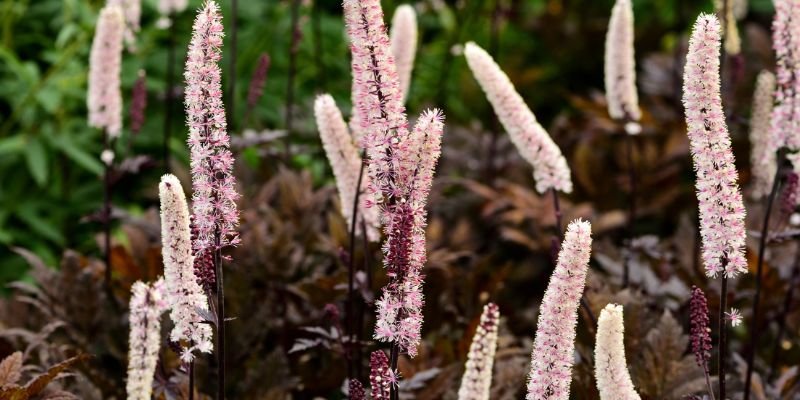
Scientific Name: Actaea
Plant Type: Perennial
Plant Size: 2-4′ tall
Sun Exposure: Part shade to full sun
Despite being classified as a flowering perennial, bugbane is a spreading shrub that has lovely bronze-purple foliage and soft pink blossoms. It thrives in semi-shaded areas when used as a border plant or in woodland gardens.
Bugbane’s blossoms emerge from pillars that fly up to five feet above the ground, while the leaves grow to a height of approximately two feet. The bottlebrush-like flowers of the “pink spire” type have a delicate, ballerina-like pink that stands out against its darker foliage.
As autumn approaches, Bugbane does yield berries instead of withering petals. The berries are poisonous, though, so people shouldn’t consume them.
28. Crape Myrtle
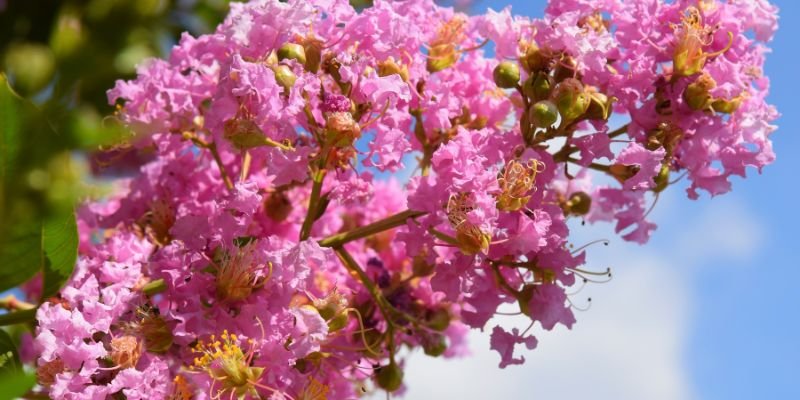
Scientific Name: Lagerstroemia
Plant Type: Deciduous shrub
Plant Size: 10-12 feet tall
Sun Exposure: Full sun
Crape Myrtles get their name from their bark, which resembles myrtle, and their blossoms, which resemble crape paper. Despite being classified as shrubs, many of them grow to be rather large and can even be grown as trees with proper pruning.
Pink flowers come in a variety of tints on a few cultivars, ranging from delicate pastels to vibrant, striking colours.
If you swiftly cut them back, their lacy flowers, which appear in late summer (July and August), will continue to bloom until autumn. The green leaves of the Crape Myrtle will become a beautiful burgundy-red when the weather gets cooler and the blossoms fall, adding more colour to your landscape.
29. Deutzia ‘Strawberry Fields’
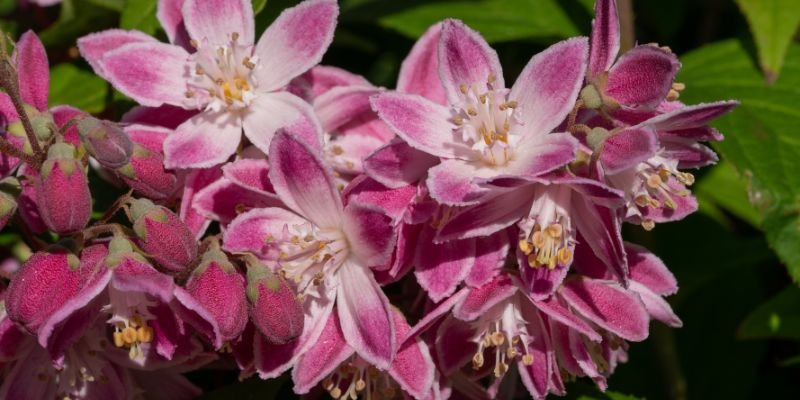
Scientific Name: Deutzia x hybrida
Plant Type: Deciduous shrub
Plant Size: 4-6′ tall
Sun Exposure: Full sun to partial shade
Deutzia longifolia and Deutzia discolour are hybridised to produce the Strawberry Fields type of Deutzia. This multi-stemmed shrub grows quickly and has lovely pink and white blooms in May and June.
However, it has a tendency to appear messy and bushy, much like any other Deutzia shrub. Consequently, to maintain this shrub’s optimum appearance, constant pruning is essential.
Also Read: Houseplants with Large Leaves
30. Korean Abelia
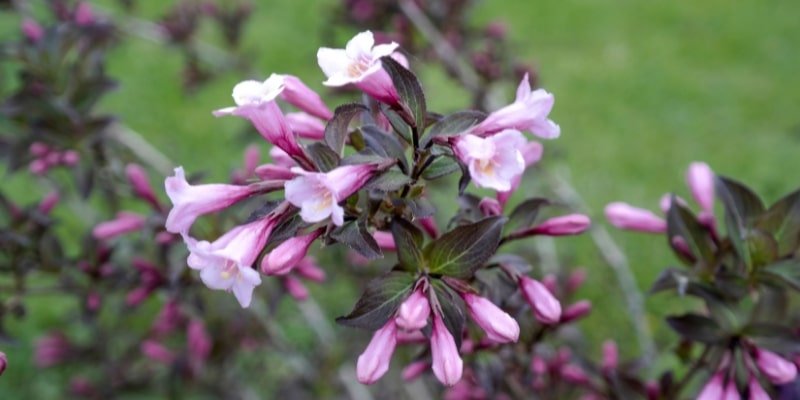
Scientific Name: Abelia mosanensis
Plant Type: Deciduous shrub
Sun Exposure: Full sun to partial shade
Plant Size: 5-6 feet tall
Beautiful Korean Abelia is a bush that offers colour all year round. Arching stems with bright pink buds blossom into creamy pink tubular flowers in the spring. Hummingbirds and butterflies are among the many pollinators drawn to these aromatic blossoms.
The blooms wither away as autumn draws near, but the green foliage of the shrub turns a vibrant orange. Furthermore, Abelia will retain its glossy leaves throughout the winter months if the climate is moderate enough.
31. Peony
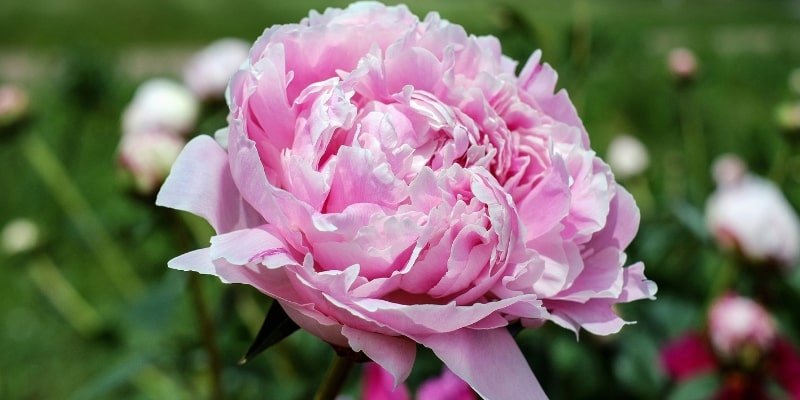
Scientific Name: Peony suffruticosa
Plant Type: Deciduous shrub
Sun Exposure: Full sun to partial shade
Plant Size: 6-8 feet tall
Peonies are available in several types. Certain shrubs are deciduous, whereas others are perennials. Peony Suffruticosa is a shrub variety that is also referred to as tree peony.
Its leaves are bluish-green, and it has strong, woody stalks. Its blossoms are available in a variety of hues, including pink.
These peonies can withstand full sun, but they do best in well-drained soil with some shade. Though they don’t flower immediately, it’s vital to remember that their flowers are huge and exquisite. In any one garden, peonies might take up to three years to establish themselves and begin to blossom.
32. Shrubby Cinquefoil
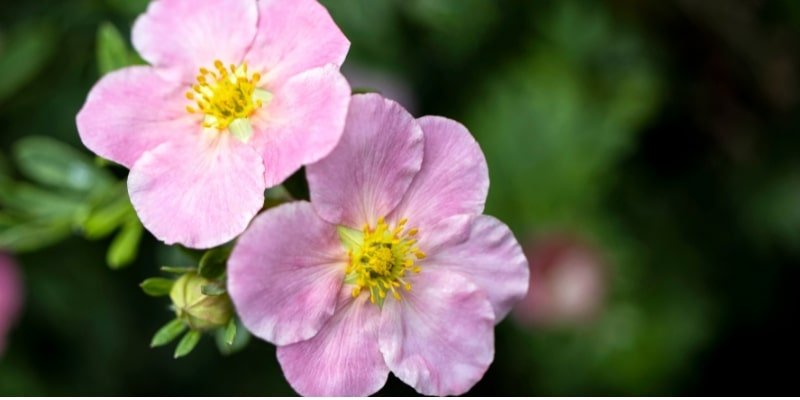
Scientific Name: Potentilla fruticosa
Plant Type: Deciduous shrub
Plant Size: 2-4 feet tall
Sun Exposure: Full sun
The compact shrub known as shrubby cinquefoil has mounded leaves that are tiny and blue-green in colour. In contrast to the typical yellow blooms of cinquefoil, the ‘Pink Beauty’ variation features vibrant pink blooms. Plant cinchofoil is incredibly resilient. It is resilient to both extremes of heat and cold.
The colourful blossoms and azure leaves are replaced with dry, tumbleweed-like growth in the winter. Pruning heavily in the late winter will prevent it from appearing too ragged, and gardeners should try to prune approximately every couple of years.
The Latin term for “potent” is the source of the plant’s scientific name, potentilla, which is a holdover from the shrub’s previous medical usage. For medicine men and women, or so-called witches and sorcerers, potentilla was a favourite since it relieved fevers and stopped sore throats.
33. Yuki Cherry Blossom
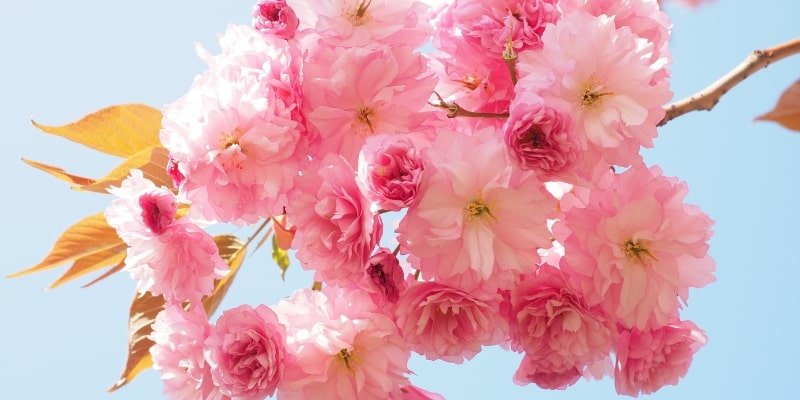
Scientific Name: Deutzia
Plant Type: Deciduous shrub
Plant Size: 1-2 feet tall
Sun Exposure: Full sun to partial shade
This little variety of Deutzia blooms throughout the spring and early summer, with pale pink, star-shaped flowers surrounded by dark green foliage. The cultivar’s name comes from the blooms’ resemblance to cherry blossoms.
The blossoms fade as the temperature drops. However, its foliage changes to a beautiful purple-bronze, giving your winter garden some colour. On banks and slopes, Yuki cherry blossoms create a great ground cover. It’s a great border plant as well.
34. Pink Forsythia

Scientific Name: Abeliophyllum distichum
Plant Type: Deciduous shrub
Plant Size: 3-5 feet tall
Sun Exposure: Partial shade to full sun
One of the first plants to greet spring is the pink forsythia, which blooms in early March. Many gardeners and florists love this early bloomer because it is aromatic and spectacular.
It also requires not too much upkeep. However, in order for the flower buds to grow for the next year, you should try to prune them just after they bloom.
While pink forsythia can withstand moderate drought, it would like not to be very damp. While it will blossom best in broad light, it can also withstand some shade.
Also Read: White Flowers
35. Meyer Lilac
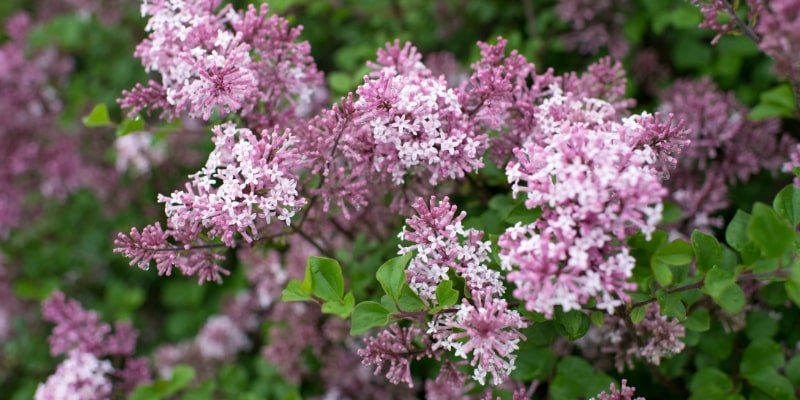
Scientific Name: Syringa meyer
Plant Type: Deciduous shrub
Plant Size: 4-8 feet tall
Sun Exposure: Full sun
The American who first discovered the Meyer lilac in a Beijing garden, Frank Meyer, is credited with giving it its name. Though it isn’t found in the wild, this compact, slow-growing shrub thrives in sunny garden areas.
In spring, thick clusters of purple-pink Meyer lilac flowers emerge. Situated atop tiny, ruffled leaves, they are aromatic and lend a lovely appearance to the entire shrub.

